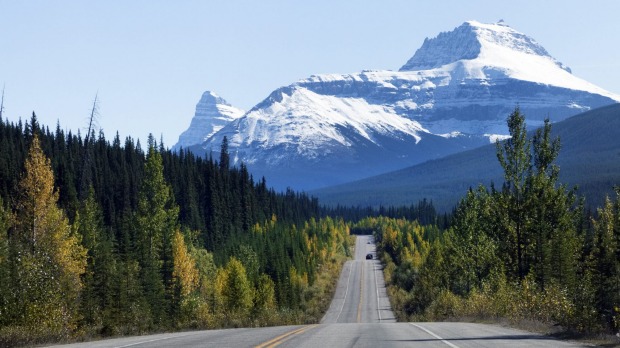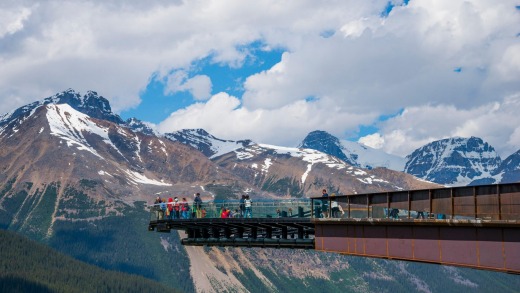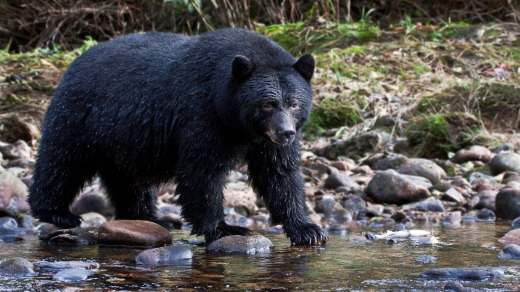
It's often best to choose your own music on a road trip but when you drive through the Canadian Rockies, go with the radio.
The stations drift in and out but there is something authentically Canadian about heading through some of the world's most magnificent mountain landscapes while hearing snatches of Alanis Morissette and Bryan Adams, local writers talking earnestly about their novels and sometimes indecipherable news about elections and winter sports.
One question - "Isn't it ironic?" - you hear more than once.

And maybe it is ironic that it takes a fuelled-up SUV to enjoy the beauty of the mountains, glaciers and turquoise lakes.
Our road trip - from Edmonton to Vancouver - is to take 10 days. On the face of it, it's a chance to see wildlife - bears if we're lucky - to get into the outdoors for biking, hiking, kayaking and fresh air, and learn about Canadian culture and history.
Without a word spoken, everyone sees a black bear foraging for food. We watch silently, the boat gliding 30 metres from the shore, as he lumbers for 200 metres, digging and eating along the way.
Garry Maddox
Three hours on the road - through mostly humdrum scenery - takes us to Hinton. After a short walk, there is a lake where beavers build their dams that has become a tourist attraction. As we were walking the three kilometres of boardwalk, one tiny critter appears on the surface briefly, carrying a small branch, but it seems late afternoon is a better time to catch them in numbers.

The first glimpse of the Rocky Mountains comes approaching Jasper National Park. Even four days into autumn, there are grand mountains capped with snow and lakes beside the road so stunning that many drivers are pulling over to take photos.
As wildlife corridors slow traffic, there are mountain goats and elk grazing by the road. The air is definitely crisper as we arrive in Jasper.
In winter, the population is a bustling 25,000. But when the snow goes in Jasper, so do most of the skiers, snowboarders and other tourists.
But it remains a town focused on outdoor activities. "You're either a hiker, mountain biker, snowshoer or cross-country skier," says Paula Beauchamp, owner of Walks and Talks Jasper. "Most of the community is into the outdoors."
She takes us on a day walk to the meadows high on Mount Edith Cavell, just out of town. In the first hour, there is a stunning view of the Angel Glacier, with squirrels darting between rocks, tiny pikas carrying grass across the trail so they can literally make hay to eat during winter and cat-sized hoary marmots lazing in the sun.
We walk up through a forest into the alpine landscape, needing regular rests as the air gets thinner. Once there, with a spectacular view of the mountains and valleys, we find a comfortable rock to sit on and have lunch before heading back down.
Like a real ski town, Jasper has no shortage of good places to stay and eat. That night I order elk at the restaurant of what looks like a European chalet town, Pyramid Lake Resort, then immediately regret it when two wander past the window.
Next day is a short, scenic drive to Maligne Lake. Wildlife expert Alicia Waller says it has been a bad year for bears. With low rainfall causing the berry crop to fail, a record number of food-stressed bears have been run over on roads and railway tracks.
There are reputedly around 200 bears in the Jasper National Park - 120 grizzlies, 80 black bears - but we are yet to see any. But there are more elk, which look docile but are responsible for three times more attacks on humans than bears, especially during rutting season.
A small boat takes us two-thirds of the way along the 22-kilometre lake, with grand, stark mountains on both sides and the water becoming progressively more turquoise from glacial sediment. There is a brief stop at one of the most famous photographic locations in the Rockies - the picturesque Spirit Island.
That afternoon, we head skywards. The Jasper Sky Tram is a cable car that takes seven minutes to reach almost 2300 metres. The guide, "Bro", is, like so many 20-somethings working in Jasper's restaurants and hotels, an Australian on a working holiday.
From the upper station, there is a 1½ -kilometre hike to the summit of Mt Whistler. But it's a hot afternoon and having met a family from Calgary, we sit for a while, take in the view over six mountain ranges and talk about Canada.
The town comes alive at night, with Evil Dave's Grill proving an entertaining place to eat surrounded by cheerful stragglers from an afternoon wedding party.
Our last day in Jasper is another spectacular drive to the new Glacier Skywalk on the Icefields Parkway – a glass walkway almost 300 metres above a valley in the Columbia Icefields. Since opening in May, it has attracted more than 260,000 visitors before closing for winter.
You grab an audio guide and follow a clifftop trail to learn about the area's history, environment and wildlife. And when you reach the walkway, any nerves about stepping onto it evaporate instantly with the magnificent view of the glacier landscapes and the sound of a waterfall somewhere below.
Waking up next morning, it is snowing. It's a treat for tourists; less so for locals who are surprised the snow has arrived so early. It adds a wintry crispness to the scenery as we drive on.
The small town of Blue River in the Monashee Mountains, two hours' drive from Jasper, has a river safari that sounds perfect for seeing bears, though the weather has turned cold and wet.
A small power boat - with tourists from Germany and Holland huddled in raincoats and under blankets - takes us into Mud Lake, a pristine place where just about the only sign of humanity is a helicopter carrying construction material on a cable in the distance.
An osprey swoops from a nest. A great blue heron pecks for food. Guide Dylan stops the boat for a short walk to a waterfall.
While the tour is only supposed to take an hour, Dylan knows what everyone is keen to see so he perseveres with a search along the shoreline. After more than 90 minutes, he suddenly cuts the motor. Without a word spoken, everyone sees a black bear foraging for food. We watch silently, the boat gliding 30 metres from the shore, as he lumbers for 200 metres, digging and eating along the way.
Everyone is buzzing when the boat returns to a hut built over the water that is the safari base. All that cold driving rain has only added to the experience.
In winter, the resort of Sun Peaks – another three hours' drive through grazing country - is all about ski-ing and snowboarding. In the off-season, it's a place to fill your lungs with oxygen doing all sorts of other activities.
It's a small, close-knit community. On the first night, we meet the mayor, Al Raine, and his wife, former ski champion and now senator Nancy Green. We were entirely ignorant of her achievements, but she politely mentions she has been described as "Canada's Dawn Fraser". Googling later shows she was named the country's female athlete of the 20th century.
We go mountain-biking on a mountain trail – lung-busting but adventurous fun - ride Segways up a ski slope early one very cold morning and meet more friendly locals, who live up to the Canadian reputation for hearty cheerfulness.
A voyageur canoe tour is the chance to learn about the fur traders - voyageurs - who opened up so much of the country from the 1770s onwards. They would trap animals for their fur - with the beaver being the most highly prized for its waterproof quality – and trade with the native First Nations people.
The tour starts with a paddle on McGillivray Lake, with guide Kevin Tessier, dressed like an old fur trader, explaining how they would set out on epic canoe trips lasting up to eight months. Then at the Voyageur Bistro, lined with artefacts and curiosities including an old canoe, there is a fur trader dinner that includes a bread called bannock, barbecued pork belly ribs, sock-eye salmon and fresh berries for dessert.
To learn more about Canada's First Nations people, we head next day to the Secwepemc Museum and Heritage Park at Kamloops. As our guide, Dan, walks us around the displays, he reveals that like so many Australian Aborigines, he was taken from his parents by the authorities as a child to live in a church-run residential school. "The idea was integration and segregation," he says. The sadness of that separation from his parents is underscored when he says that instead of his family name, he was known at the school as "No. 154".
Leaving Sun Peaks, the BC Wildlife Park at Kamloops proves well worth a stop. We arrive just as two grizzlies, Dawson and Knute, are being fed.
Raised in captivity after being orphaned in the Yukon as cubs, they happily move into a caged area while their keeper hides food around their enclosure, including whole salmon under rocks and apples stuck on tree branches. While the bears take great enjoyment hunting down their lunch, their genial appearance is deceptive. "People say they're like dogs," says their keeper. "But they're not. They're dogs times a thousand."
On a weekday afternoon, we almost have the park to ourselves and see wolves, moose, cougars and birds of prey.
Into the rich agricultural land around Vernon, we stay at Sparkling Hill Resort, a European-style "wellness retreat" overlooking Lake Okanagan, and cycle along an abandoned railway that has been turned into a bike path through tunnels and over trestle bridges.
The final drive - five hours to Vancouver - covers some of the best roads and most spectacular scenery of the trip.
Around Hope, the highway weaves between majestic, forested mountains that seem untouched by civilisation. Ironic or not, the road through the Rockies has many magical turns.
The writer was a guest of Tourism Alberta, Destination British Columbia and the Canadian Tourism Commission.
canada.travel
Air Canada flies to Edmonton via Vancouver daily, with connecting flights to Edmonton. See aircanada.com.
In Jasper, the three star Pyramid Lake Resort has rooms from $125 $ a night outside the ski season and an upmarket restaurant overlooking a lake. The more centrally-located Sawridge Inn has rooms from $107 a night as well as three restaurants and an indoor pool. In Sun Peaks, Kookaburra Lodge has one to four-bedroom apartments from $190 a night outside the ski season. In Vernon, Sparkling Hill Resort has rooms from $195 a night.